TURTLES
In Pennsylvania, turtles make up four families, representing 10 genera and 14 species and subspecies.
The unusual physical structure of the turtles makes them one of the most familiar and easily recognized of all our amphibians and reptiles. The distinctive shell that protects the turtle's body is unique and known to nearly everyone. The shell's shape, size, color and pattern can help identify several of the species. The upper shell, called the carapace, comes in a variety of shapes and markings. The plastron, or lower shell, varies in size and in some species is equipped with one or two hinges that allow it to move or swing open and shut. This feature provides these turtles effective protection when they withdraw their legs and head and close up the shell tightly. Large scales, which actually are horny plates called scutes, cover the shells.
Turtles are our oldest living reptiles and have gone practically unchanged in the 200 million years they have been in existence. They also are considered to be the more intelligent of the reptiles. Turtles have adapted to a variety of environments. Some are fully aquatic, never leaving the water except to lay eggs. Others, though they reside near water, seldom enter it. All turtles enjoy basking and often can be seen soaking up the rays of the warm sun.
Pennsylvania's turtle species are often on the move during late spring and early summer, as the females look for places to lay their eggs. Learn how to help them safely cross the road.
SNAPPING TURTLE
Chelydra serpentina
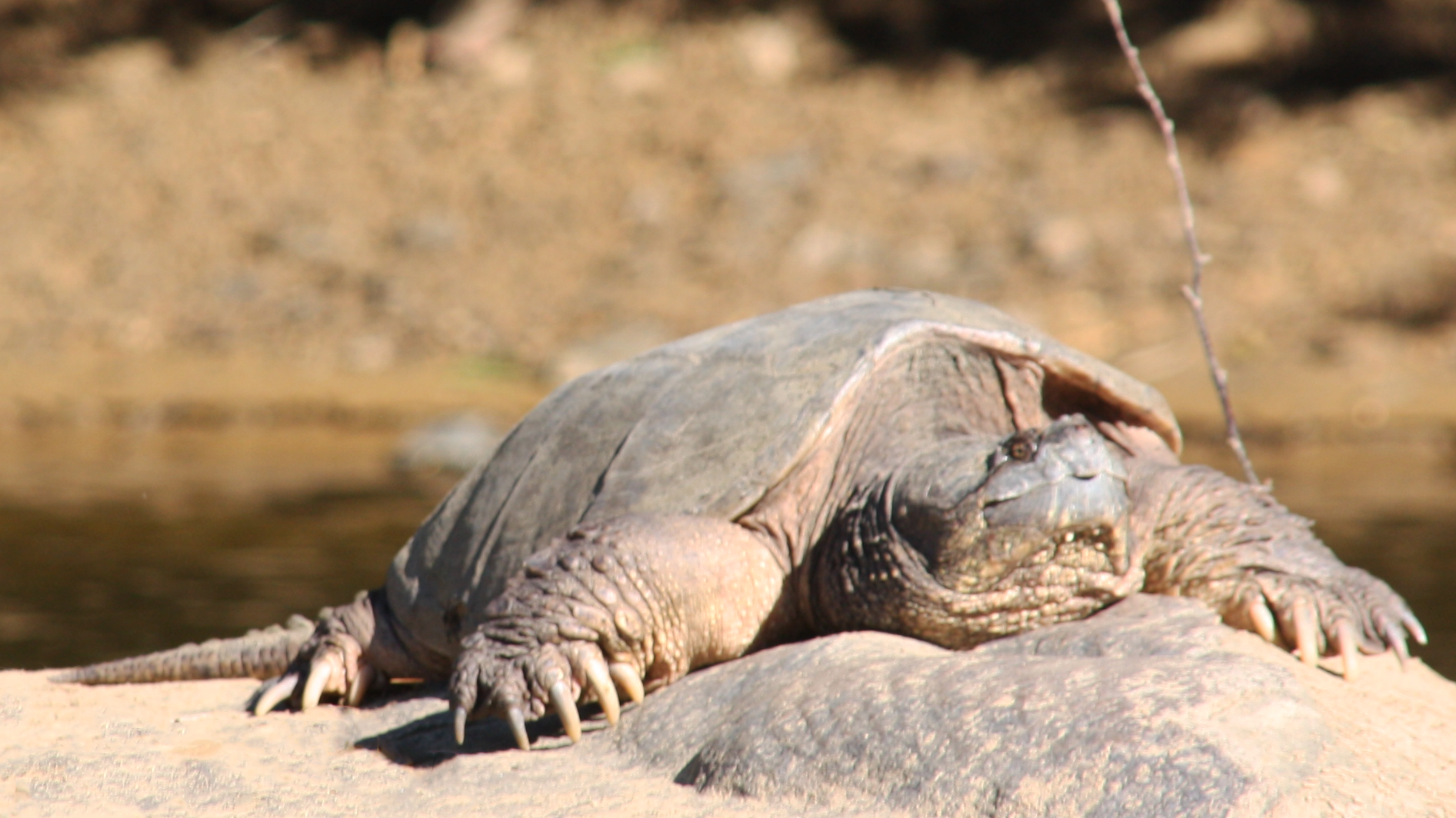 The common snapping turtle is sometimes referred to as the freshwater "loggerhead" and is the only turtle in Pennsylvania with any economic value. This turtle is commonly sought for its meat, which is considered a delicacy and a base for snapper soup. In Pennsylvania, a fishing license is required to take snapping turtles and traps or set lines may be used.
The common snapping turtle is sometimes referred to as the freshwater "loggerhead" and is the only turtle in Pennsylvania with any economic value. This turtle is commonly sought for its meat, which is considered a delicacy and a base for snapper soup. In Pennsylvania, a fishing license is required to take snapping turtles and traps or set lines may be used.
Many people think the snapping turtle is ugly, both in appearance and disposition. Although on land it may lash out viciously, it is generally inoffensive when submerged in water where it spends most of its time. It does not bask in the sun nearly as much as many other turtles do. The snapping turtle is a good swimmer but more often than not prefers to walk across the bottom of its watery habitat, which it does quite well. Confronted on land, the common snapping turtle is quick to assume its offensive stance, in which the hind quarters are elevated above the rest of the body, and the jaw is opened wide, at which time the turtle may lunge forward repeatedly. During such shows of strength, the snapper may emit a loud hissing sound to discourage further any would-be adversary. The common snapping turtle is one of our largest turtles. Its carapace may measure up to 12 inches in length.
SOUTHEASTERN MUD TURTLE
Kinosternon subrubrum subrubrum
ENDANGERED SPECIES - SPECIES ACTION PLAN
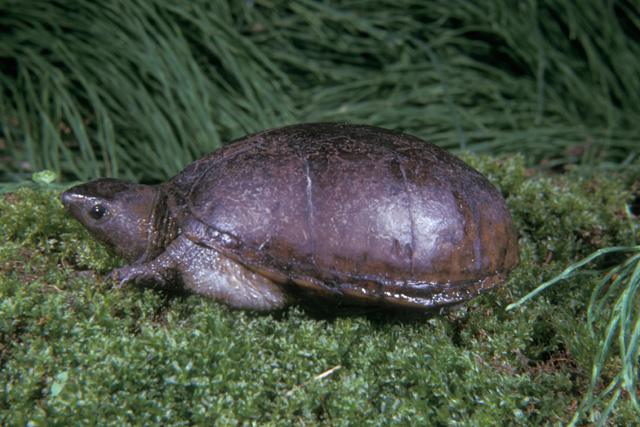 The eastern mud turtle is more an aquatic animal, so draining wetlands and filling in swamps and marshlands has had a predictable adverse effect on the population. A small turtle, the eastern mud turtle reaches an upper shell length of only three to four inches. It has few, if any, distinctive field marks. The carapace may range from and olive to a dark brown or almost black. There is no definitive pattern or markings. The upper shell is smooth and the scales, or scutes, have no keels. The plastron is yellow to brown and may be marked at times with black or brown. The lower shell is double-hinged and contains 11 scutes. The head of the eastern mud turtle is brown and marked with numerous widespread yellow spots or streaks. On the male, the tail ends in a well-developed blunt spine.
The eastern mud turtle is more an aquatic animal, so draining wetlands and filling in swamps and marshlands has had a predictable adverse effect on the population. A small turtle, the eastern mud turtle reaches an upper shell length of only three to four inches. It has few, if any, distinctive field marks. The carapace may range from and olive to a dark brown or almost black. There is no definitive pattern or markings. The upper shell is smooth and the scales, or scutes, have no keels. The plastron is yellow to brown and may be marked at times with black or brown. The lower shell is double-hinged and contains 11 scutes. The head of the eastern mud turtle is brown and marked with numerous widespread yellow spots or streaks. On the male, the tail ends in a well-developed blunt spine.
In Pennsylvania, the eastern mud turtle inhabited the extreme southeastern corner of the state, particularly in the lower Delaware River Valley. In this heavily populated area much of its habitat has been destroyed, accounting for its dwindling numbers. Its natural range extends south from here to the Gulf Coast, and north to Connecticut.
EASTERN MUSK TURTLE
Sternotherus odoratus
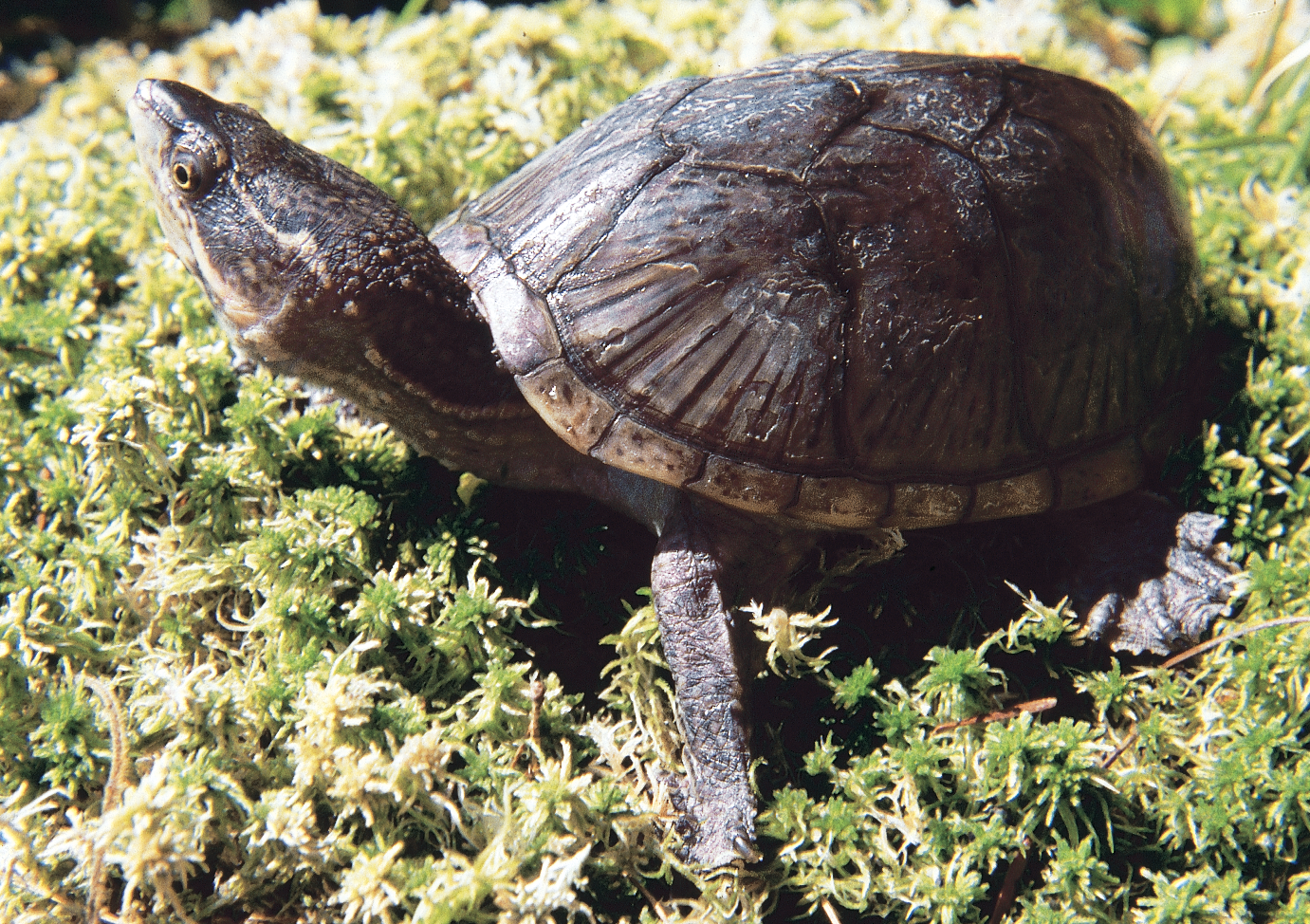 The eastern musk turtle is the only musk turtle inhabiting Pennsylvania. Although abundant in many waters within its range, it often is not seen because it is primarily an aquatic animal. Nonetheless, it likes to leave the water to bask in the sun, and quite mobile, often climbs slanted trees or logs to find a resting place. An apparent ability over other turtles to climb steeper surfaces is provided by a smaller plastron, which allows greater movement of the legs. The carapace measures three inches to just over four inches in adults. In clear water the eastern musk turtle might be observed walking across the bottom in search of food. It often is caught by a surprised angler. When disturbed, it is liable to secrete a foul-smelling yellowish fluid. This fluid, which acts in many cases as a deterrent to would-be attackers, is discharged from two pairs of musk glands located under the border of the upper shell. Some have described the stinkpot as pugnacious, almost vicious. It is said to have a short temper and strong jaws.
The eastern musk turtle is the only musk turtle inhabiting Pennsylvania. Although abundant in many waters within its range, it often is not seen because it is primarily an aquatic animal. Nonetheless, it likes to leave the water to bask in the sun, and quite mobile, often climbs slanted trees or logs to find a resting place. An apparent ability over other turtles to climb steeper surfaces is provided by a smaller plastron, which allows greater movement of the legs. The carapace measures three inches to just over four inches in adults. In clear water the eastern musk turtle might be observed walking across the bottom in search of food. It often is caught by a surprised angler. When disturbed, it is liable to secrete a foul-smelling yellowish fluid. This fluid, which acts in many cases as a deterrent to would-be attackers, is discharged from two pairs of musk glands located under the border of the upper shell. Some have described the stinkpot as pugnacious, almost vicious. It is said to have a short temper and strong jaws.
PAINTED TURTLE
Chrysemys picta
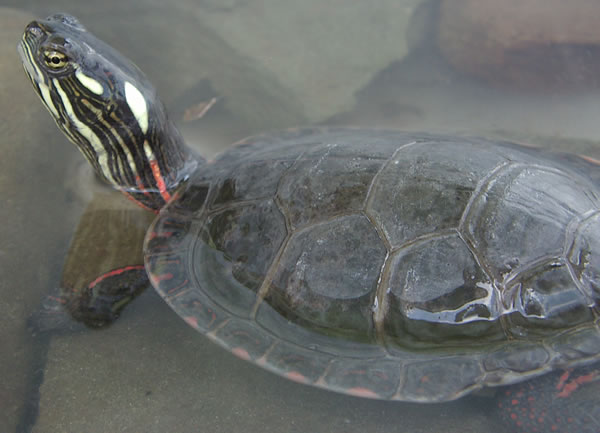 The attractive painted turtle is the most widespread of any in North America. One subspecies with intergrades, which may show characteristics from other subspecies in adjoining areas, is found in Pennsylvania. Not a particularly large turtle, it attains adult sizes of four to six inches along the upper shell, or carapace.
The attractive painted turtle is the most widespread of any in North America. One subspecies with intergrades, which may show characteristics from other subspecies in adjoining areas, is found in Pennsylvania. Not a particularly large turtle, it attains adult sizes of four to six inches along the upper shell, or carapace.
The carapace is olive or black, oval, smooth, and somewhat flattened. Red and black markings on the edges of the shell, in the form of bars or crescent-shaped patterns, are good identifying characteristics. The plastron is an unmistakable yellow or red with a dark blotch in its center. Each side of the head is marked with bright-yellow spots and stripes (See Figure IV-9), and yellow and red stripes define the neck, legs and tail. The upper jaw is notched.
SPOTTED TURTLE
Clemmys guttata
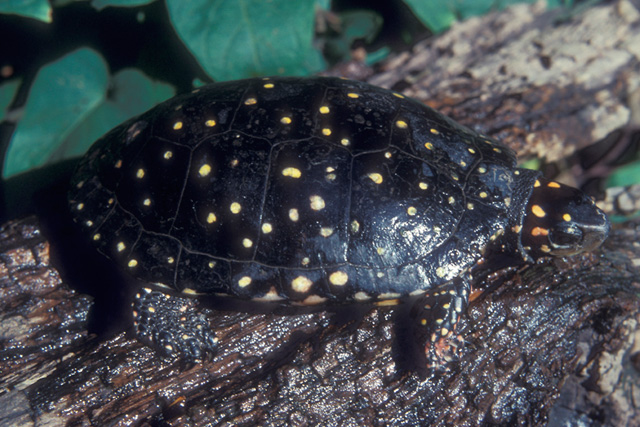 The spotted turtle is found in fairly good numbers throughout its range, unlike its close cousin, the endangered bog turtle. This turtle is small with an upper shell length of only three to slightly more than four inches. It likes to bask in clumps of grasses, especially during the cooler spring months, and is more often seen during the spring than any other time of the year.
The spotted turtle is found in fairly good numbers throughout its range, unlike its close cousin, the endangered bog turtle. This turtle is small with an upper shell length of only three to slightly more than four inches. It likes to bask in clumps of grasses, especially during the cooler spring months, and is more often seen during the spring than any other time of the year.
The carapace of this small turtle is black and without keels on the scales. Its upper shell is sprinkled with round yellow spots that vary greatly in number from one specimen to another. The head, neck and legs are marked with yellow or orange spots. Its black head has an orange spot over the eyes. The lower shell, or plastron, is creamy yellow and bordered with large black blotches. The female has orange eyes and a yellow chin. The male has brown eyes and a tan chin. The male also has a long, thick tail.
WOOD TURTLE
Glyptemys insculpta
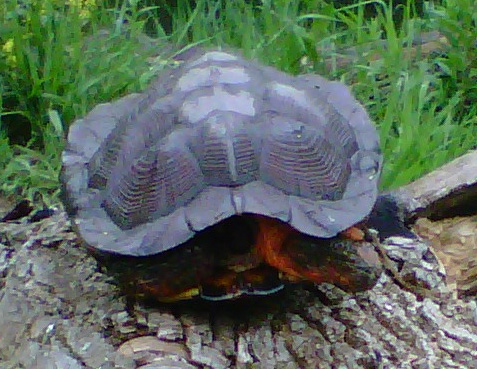 The wood turtle is often called the "sculptured turtle." Looking at its upper shell, it is easy to understand how it obtained this descriptive nickname. Its carapace appears as if an artist had taken a fine-edged knife and carefully carved an intricate, nearly symmetrical pattern from a piece of dark wood. Adults grow until the upper shell measures five to almost eight inches in length. Other than the box turtle, the wood turtle is Pennsylvania's most terrestrial turtle. During the late 1800s to early 1900s, this turtle was available at market for its meat.
The wood turtle is often called the "sculptured turtle." Looking at its upper shell, it is easy to understand how it obtained this descriptive nickname. Its carapace appears as if an artist had taken a fine-edged knife and carefully carved an intricate, nearly symmetrical pattern from a piece of dark wood. Adults grow until the upper shell measures five to almost eight inches in length. Other than the box turtle, the wood turtle is Pennsylvania's most terrestrial turtle. During the late 1800s to early 1900s, this turtle was available at market for its meat.
The upper shell of the wood turtle is brown and keeled. Its scutes, or large scales, are pyramidal, a series of concentric growth ridges and grooves, larger on the bottom, becoming smaller as they approach the top. These exaggerated scales appear sculptured and are rough to the touch. The plastron, or lower shell, is yellow, and each of the scutes is margined on the outer edge with black blotches. The plastron is hingeless and can aid in distinguishing this turtle from the box and Blanding's turtles, which are considered "land" turtles like the wood turtle. The lower shell of the male is concave. The female's lower shell is flat or slightly convex. The skin on the neck and front legs is frequently reddish orange. The tail is moderately heavy and nearly as long as the carapace, or upper shell.
The PFBC conducts regular population assessments to improve its knowledge and understanding of the wood turtle in Pennsylvania.
BOG TURTLE
Glyptemys muhlenbergii
ENDANGERED SPECIES - SPECIES ACTION PLAN
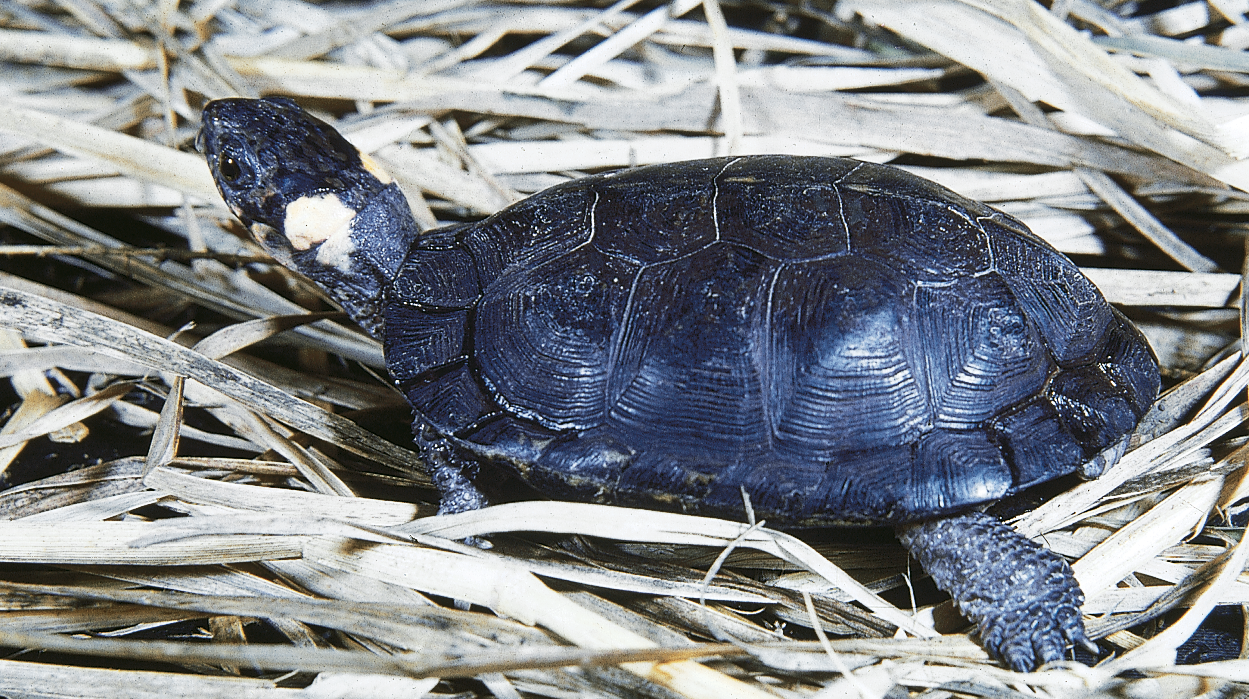 The bog turtle was the first turtle to be placed on the Pennsylvania List of Endangered Species. It now appears only in isolated populations. Loss of habitat has been the biggest factor in its decline. Mankind's propensity for draining bogs, marshes and swampland has taken its toll on the bog turtle. Its habitat left high and dry, the bog turtle simply had no place to go. Some years ago, the pet trade also was a factor in the decline in populations of this species.
The bog turtle was the first turtle to be placed on the Pennsylvania List of Endangered Species. It now appears only in isolated populations. Loss of habitat has been the biggest factor in its decline. Mankind's propensity for draining bogs, marshes and swampland has taken its toll on the bog turtle. Its habitat left high and dry, the bog turtle simply had no place to go. Some years ago, the pet trade also was a factor in the decline in populations of this species.
The bog turtle, sometimes referred to as Muhlenberg's turtle, is a secretive reptile. Scientists actively engaged in restoration efforts find that the bog turtle's retiring attitude makes it a difficult animal to study. In spite of its shy nature, it still likes to bask in full sunlight, often atop tufts of grass or perched on a log. The bog turtle is active from April through mid-October, perhaps a bit longer period than some turtles. It may bury itself and become inactive during the hot days of summer. The bog turtle is a small turtle, never reaching more than three or four inches long along its shell.
BLANDING'S TURTLE
Emydoidea blandingii
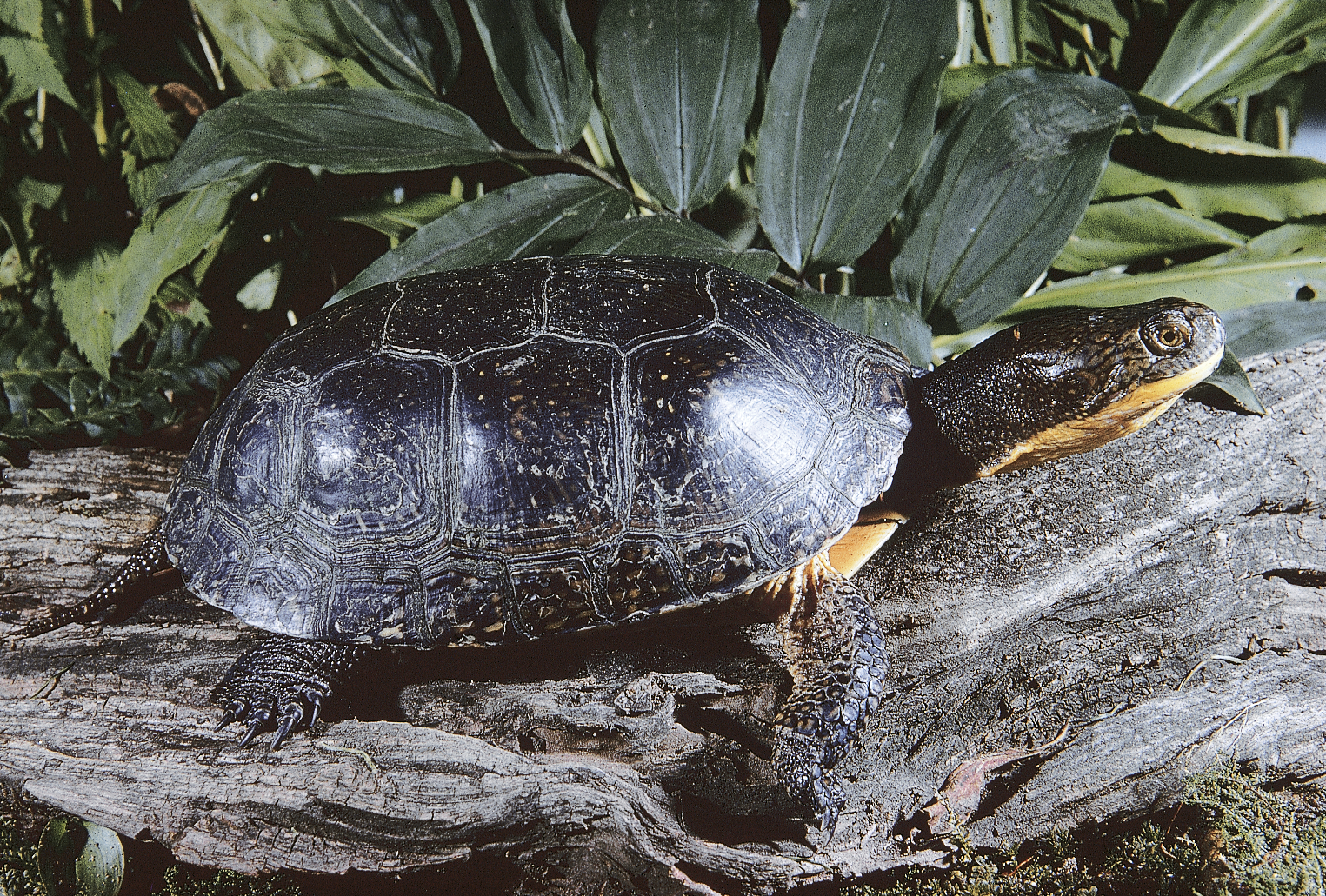 This turtle was named for Dr. William Blanding, a nineteenth-century Philadelphia naturalist who first observed the species. It grows to an average adult shell length of five to just over seven inches. The Blanding's turtle is more tolerant of cold temperatures than most other turtles.
This turtle was named for Dr. William Blanding, a nineteenth-century Philadelphia naturalist who first observed the species. It grows to an average adult shell length of five to just over seven inches. The Blanding's turtle is more tolerant of cold temperatures than most other turtles.
The Blanding's turtle has a carapace that is smooth and shaped like a helmet. It is sprinkled with a heavy profusion of pale-yellowish spots, which in some areas become connected to form vermiculations. The plastron, or lower shell, is yellow and accented with large black blotches. The chin and throat are both bright yellow. In Pennsylvania, only the softshell turtle has a longer neck. Large protruding eyes serve only to emphasize a flat head. The plastron is hinged so that it can be closed toward the carapace, but not to the extent the box turtle is able to close up.
NORTHERN MAP TURTLE
Graptemys geographica
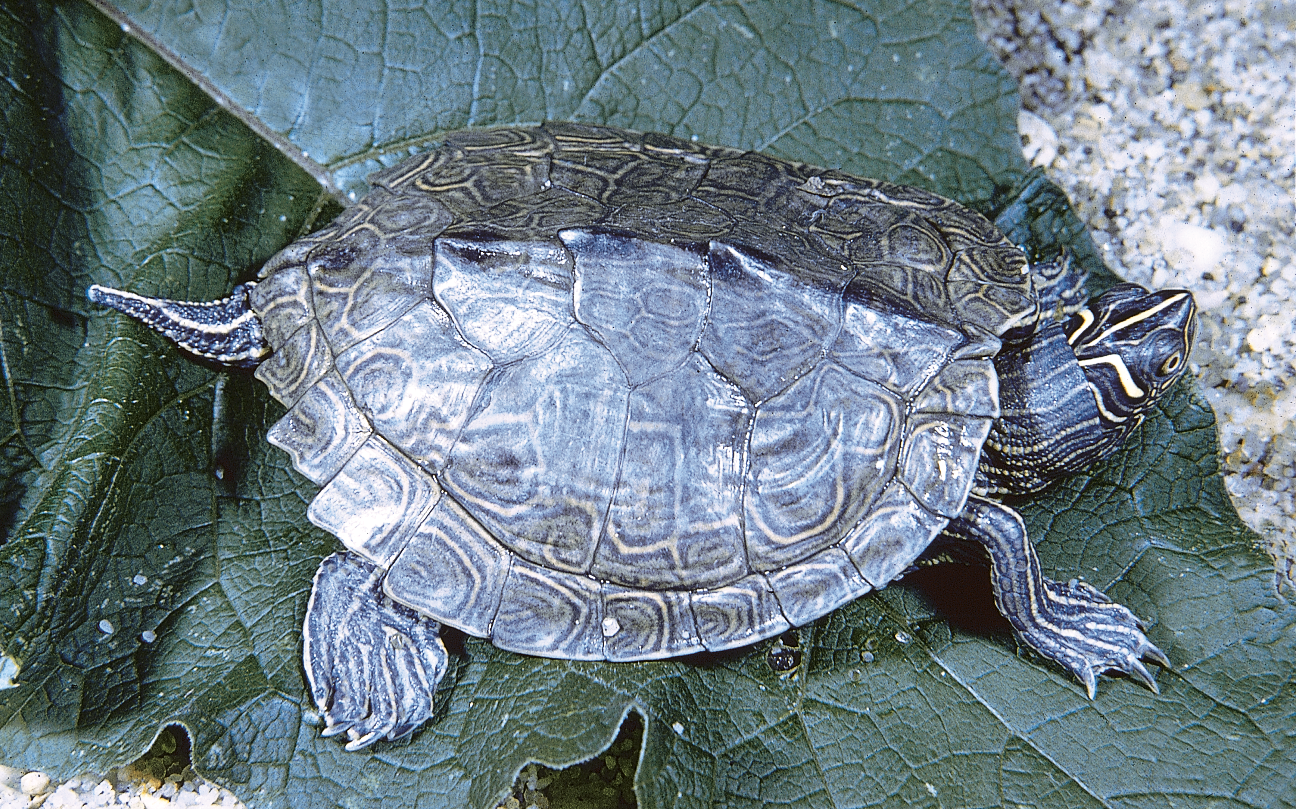 A moderately large turtle, though certainly not the largest found in Pennsylvania, the map turtle reaches an average seven to 11 inches in shell length. It is fairly common throughout its Pennsylvania range. Perhaps due to limited basking sites, individual turtles often pile on top of one another while basking on rocks or logs, which is a favorite pastime. But it also is a shy animal and if disturbed will slip quickly into the water to avoid a potential predator.
A moderately large turtle, though certainly not the largest found in Pennsylvania, the map turtle reaches an average seven to 11 inches in shell length. It is fairly common throughout its Pennsylvania range. Perhaps due to limited basking sites, individual turtles often pile on top of one another while basking on rocks or logs, which is a favorite pastime. But it also is a shy animal and if disturbed will slip quickly into the water to avoid a potential predator.
The carapace of the map turtle is greenish to olive-brown. Its irregular pattern of thin, yellow-orange lines networking randomly across the upper shell like roads on a map give this turtle its name. The carapace is somewhat flattened and marked with a distinct keel. The plastron is yellowish and bears no markings of any significance. Its head, neck and tail are accented with narrow yellow lines. A yellow, somewhat triangular spot appears behind each eye.
NORTHERN RED-BELLIED COOTER
Pseudemys rubriventris
THREATENED SPECIES - SPECIES ACTION PLAN
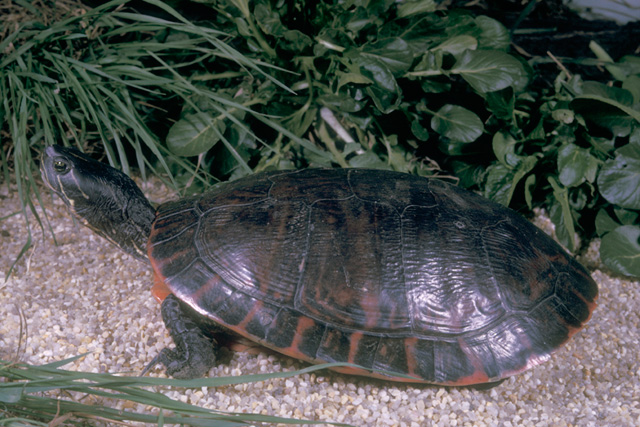 This sun-loving turtle is one of our largest. It is alert and active, but at the same time, a shy reptile. Another of Pennsylvania's threatened species, the northern red-bellied cooter, like so many other animals, is a victim of people's desire for the better life. Destruction of the habitat frequented by this colorful creature is blamed for its declining populations. A fairly large turtle, the redbellied turtle grows to an average upper shell length of 10 inches to better than 12 inches.
This sun-loving turtle is one of our largest. It is alert and active, but at the same time, a shy reptile. Another of Pennsylvania's threatened species, the northern red-bellied cooter, like so many other animals, is a victim of people's desire for the better life. Destruction of the habitat frequented by this colorful creature is blamed for its declining populations. A fairly large turtle, the redbellied turtle grows to an average upper shell length of 10 inches to better than 12 inches.
The carapace varies from brown to black and it usually has a mottled pattern of reddish brown. Several vertical red bars run from the center of the shell to its outer edge. The lower shell, or plastron, while sometimes coral-colored, more often is yellow to reddish. There is a prominent notch at the tip of the upper jaw, and an arrow-shaped stripe runs atop the head between the eyes to the snout.
WOODLAND BOX TURTLE
Terrapene carolina carolina
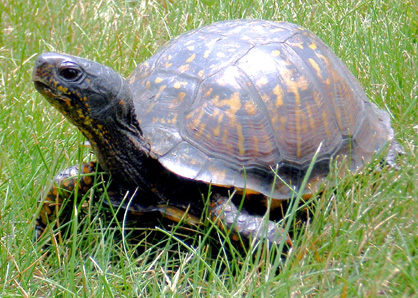 Because it is primarily a terrestrial animal, the box turtle is perhaps the one turtle species most often seen in its range. Many people have had the opportunity to identify a box turtle because it occurs in urban as well as suburban areas. It usually moves about in the early part of the day or soon after a summer rain. The woodland box turtle reaches an average shell length of just over four inches to as much as six inches as an adult.
Because it is primarily a terrestrial animal, the box turtle is perhaps the one turtle species most often seen in its range. Many people have had the opportunity to identify a box turtle because it occurs in urban as well as suburban areas. It usually moves about in the early part of the day or soon after a summer rain. The woodland box turtle reaches an average shell length of just over four inches to as much as six inches as an adult.
The carapace of the eastern box turtle is high-domed and keeled. Color and patterns vary greatly, but black or brown are probably most often seen, with markings of yellow, orange or olive. The sharply rising dome-shaped upper shell is a good identifying characteristic. The colors on the plastron are quite varied. Markings may range from yellow-orange to olive, on a tan, brown or black background. The plastron has a single broad, movable hinge that allows the box turtle to close it tightly against the upper shell. It thus becomes effective protection from predators or other disturbances. The male usually has red eyes, and the eyes of the female are normally yellowish brown. The upper jaw ends in a down-turned beak.
EASTERN SPINY SOFTSHELL
Apalone spinifera spinifera
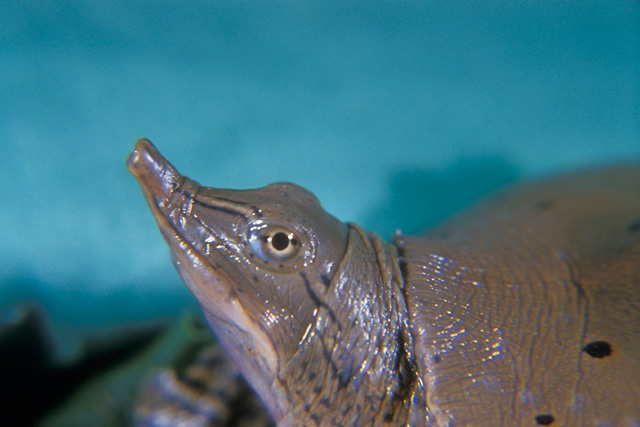 The eastern spiny softshell turtle is a completely aquatic reptile, leaving the water only to deposit its eggs or on occasion to bask on a sun-baked log or the shoreline. Even then, it suns itself only in an area that provides quick access to the water. It might also be seen atop a mass of floating debris, soaking up the warming rays of the sun. In shallow water, the softshell turtle has a habit of lying buried in the sand or mud with only its eyes and snout exposed. By extending its long neck the nostrils can reach the surface to take in air. Thus, the softshell turtle is able to soak itself in this manner for extended periods. The softshell turtle is able to move fast on land and in the water. It is a powerful swimmer and extremely agile on land where it nearly runs if it needs to. The eastern spiny softshell turtle can reach large sizes. The length of the carapace in adults may reach from five inches to as much as 17 inches.
The eastern spiny softshell turtle is a completely aquatic reptile, leaving the water only to deposit its eggs or on occasion to bask on a sun-baked log or the shoreline. Even then, it suns itself only in an area that provides quick access to the water. It might also be seen atop a mass of floating debris, soaking up the warming rays of the sun. In shallow water, the softshell turtle has a habit of lying buried in the sand or mud with only its eyes and snout exposed. By extending its long neck the nostrils can reach the surface to take in air. Thus, the softshell turtle is able to soak itself in this manner for extended periods. The softshell turtle is able to move fast on land and in the water. It is a powerful swimmer and extremely agile on land where it nearly runs if it needs to. The eastern spiny softshell turtle can reach large sizes. The length of the carapace in adults may reach from five inches to as much as 17 inches.
The eastern spiny softshell turtle primarily is a lake and large river dweller. Its favorite habitat includes sand and mud bars into which it can easily dig and bury itself. Although it prefers fast-flowing rivers, it may also inhabit lakes, farm ponds and marshy creeks.
The Pennsylvania Amphibian and Reptile Survey (PARS) helps determine the distribution and status of all amphibians and reptiles, including turtles, throughout Pennsylvania.